Speed indicator MITSUBISHI 380 2005 Workshop Manual
[x] Cancel search | Manufacturer: MITSUBISHI, Model Year: 2005, Model line: 380, Model: MITSUBISHI 380 2005Pages: 1500, PDF Size: 47.87 MB
Page 5 of 1500

GENERAL DESCRIPTION
SIMPLIFIED WIRING SYSTEM (SWS)54B-5
INTERMITTENT CONTROL
ETACS-ECU uses the dial position of the variable
intermittent wiper control switch and the vehicle
speed signal sent by the combination meter to calcu-
late the interval to be sent to the front-ECU. The
front-ECU determines the intermittent time from the
input SWS data signal, and turns ON the windshield
wiper drive signal. When the wiper is at the STOP
position, the windshield wiper auto-stop signal goes
OFF to turn OFF the windshield wiper drive signal.
After the intermittent time from when the windshield
wiper drive signal turned ON, the windshield wiper
drive signal is turned ON again and the above opera-
tion is repeated.
.
MIST WIPER CONTROL
When the ignition switch is in the ACC or ON posi-
tion, and the windshield mist wiper switch of the col-
umn switch is turned ON, the front-ECU turns ON the
windshield wiper drive signal. At the same time, the
wiper speed switching relay is turned ON
(HIGH-SPEED). While the windshield mist wiper
switch is ON, the windshield wiper will operate at
high speed. Then, if the windshield mist wiper switch
is turned off, the wiper operates at low speed until it
stops at the predetermined park position.
When the windshield mist switch is turned on briefly,
the wiper operates once at low speed.
At the point the windshield mist switch is turned ON,
if the windshield wiper has been operating intermit-
tently, the same operations as the above will be per-
formed while the windshield mist wiper switch is ON.
After the windshield mist wiper switch goes OFF, the
intermittent operations will be set again after the
windshield wiper auto-stop signal last is turned ON.
.
WASHER CONTROL
When the ignition switch is in the ACC or ON posi-
tion, and the windshield washer switch of the column
switch is turned ON, the front-ECU turns ON the
windshield washer relay. The windshield wiper drive
signal is turned ON in 0.15 seconds until 2 seconds
after the windshield washer switch goes OFF to
operate the windshield wiper continuously. When the
windshield washer switch is turned ON, if the wind-
shield wiper is operating intermittently, intermittent
operations will be continued after continuous opera-
tions.
HEADLAMP
.
HEADLAMP AUTOMATIC SHUTDOWN
FUNCTION
Even if the lighting switch (tail lamp switch or
headlamp switch) is ON, the headlamps and tail
lamps will automatically go off in the following condi-
tions to prevent the battery from discharging:
When the ignition key is turned from "ON" to "LOCK"
(OFF) or "ACC" position with the lighting switch
turned ON, and this state continues for three min-
utes, the lamp will automatically be turned off. If the
driver's seat door is opened during these three min-
utes, the lamp will go off one second later.
.
HIGH-BEAM INDICATOR
At the same time that the high beams are illumi-
nated, the ETACS-ECU sends a signal to illuminate
the high-beam indicator via the CAN bus line. The
combination meter receives the transmitted signal
and turns the high-beam indicator on and off.
FLASHER TIMER
.
TURN-SIGNAL LAMP
The turn-signal lamp output (flashing signal) is
turned ON when the ignition switch is ON and the
turn-signal lamp switch is ON (LH or RH). If the front
turn-signal lamp or rear turn-signal lamp bulb has
burned out, the flashing speed increases to indicate
that the bulb has burned out.
.
HAZARD WARNING LAMP
Detects the signal where the hazard warning lamp
switch input changes from OFF to ON, and reverse
the flashing state according to this signal. The haz-
ard warning lamps toggle on and off whenever the
hazard warning lamp switch is operated.
.
TURN-SIGNAL INDICATORS
At the same time that the turn-signal lamps are illu-
minated, the ETACS-ECU sends a signal to illumi-
nate the turn-signal lamp indicator via the CAN bus
line. The combination meter receives the transmitted
signal and turns the turn-signal lamp indicator on and
off.
Page 7 of 1500

GENERAL DESCRIPTION
SIMPLIFIED WIRING SYSTEM (SWS)54B-7
SEAT BELT INDICATOR
If any of the following conditions is met with the igni-
tion switch at "ON" or "ST", the ETACS-ECU illumi-
nates, flashes or extinguishes the seat belt indicator
by using the driver's seat belt switch signal and the
vehicle speed signal sent from the combination
meter.
Illuminates when the ignition switch is at "ON"
and the seat belt switch is turned on (the driver's
seat belt is unfastened).
Flashes and illuminates the indicator 12 cycles
(after 0.5 seconds) if any of the following condi-
tions is met when sixty seconds or more have
elapsed since the ignition switch is turned "ON".
One cycle consists of five-second "flashing" and
then three-second "illumination".
a. The vehicle speed has reached 8 km/h (5
mph) while the seat belt switch is turned on
(driver's seat belt is not fastened) with the
ignition switch "ON.
b. The seat belt switch has been turned on
(driver's seat belt has not been fastened) for
at least ten seconds while the ignition switch
has been turned "ON" and the vehicle speed
has been 8 km/h (5 mph) or more.
NOTE: Once this timer operation has been acti-
vated, it will not be activated again until the
vehicle speed reduces to 3 km/h (2 mph) or
less even if any of the following conditions is
met.
The indicator stops illuminating if the ignition
switch or the seat belt switch is turned off (the
driver's seat belt is fastened) while the timer
operation is active.
DOOR-AJAR INDICATOR LAMP
The combination meter receives the signal sent from
the ETACS-ECU about whether each door or trunk is
open or closed and turns the door ajar indicator lamp
on and off. While the door ajar indicator is illumi-
nated, the door ajar warning function is activated and
the door ajar indicator lamp flashes 4 times. If the
door remains open even after the 4 warning flashes,
the door ajar indicator lamp will be illuminated again.
CONFIGURATION FUNCTION
The following functions can be adjusted by operating
the middle-grade multi center display (if equipped).
Keyless entry horn answerback function
Keyless entry hazard lamp answerback function
Timed locking mechanism
Turn-signal lamp buzzer
Door ajar warning buzzer
Adjustment of door unlocking operation on key-
less entry system
Vehicle speed-dependent wiper function
Headlamp automatic shutdown function
Delay-off time of the dome lamp
Interior lamp automatic shutoff function
Initialisation of above mentioned functions
Page 309 of 1500
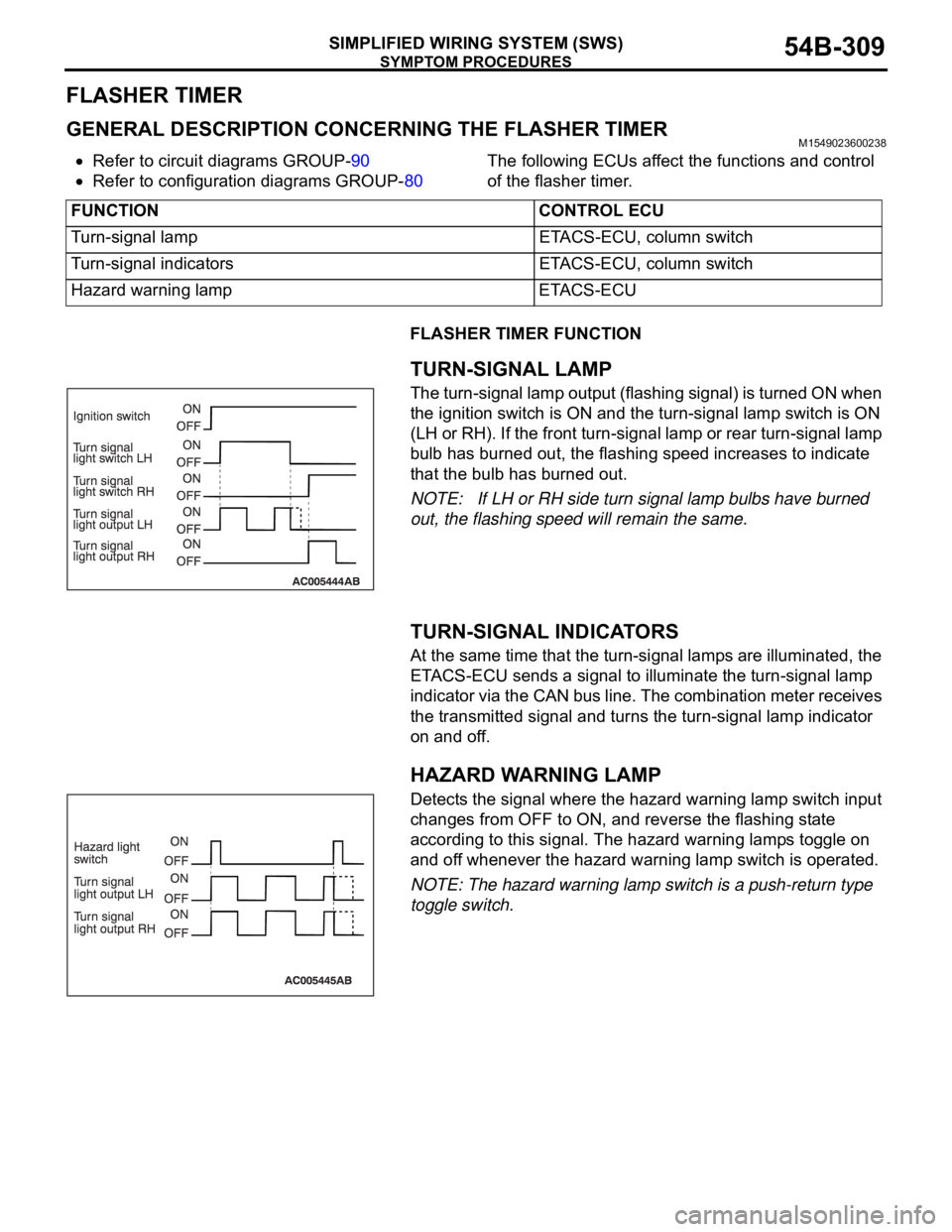
SYMPTOM PROCEDURES
SIMPLIFIED WIRING SYSTEM (SWS)54B-309
FLASHER TIMER
GENERAL DESCRIPTION CONCERNING THE FLASHER TIMERM1549023600238
Refer to circuit diagrams GROUP-90
Refer to configuration diagrams GROUP-80The following ECUs affect the functions and control
of the flasher timer.
FLASHER TIMER FUNCTION
.
TURN-SIGNAL LAMP
The turn-signal lamp output (flashing signal) is turned ON when
the ignition switch is ON and the turn-signal lamp switch is ON
(LH or RH). If the front turn-signal lamp or rear turn-signal lamp
bulb has burned out, the flashing speed increases to indicate
that the bulb has burned out.
NOTE: If LH or RH side turn signal lamp bulbs have burned
out, the flashing speed will remain the same.
.
TURN-SIGNAL INDICATORS
At the same time that the turn-signal lamps are illuminated, the
ETACS-ECU sends a signal to illuminate the turn-signal lamp
indicator via the CAN bus line. The combination meter receives
the transmitted signal and turns the turn-signal lamp indicator
on and off.
.
HAZARD WARNING LAMP
Detects the signal where the hazard warning lamp switch input
changes from OFF to ON, and reverse the flashing state
according to this signal. The hazard warning lamps toggle on
and off whenever the hazard warning lamp switch is operated.
NOTE: The hazard warning lamp switch is a push-return type
toggle switch. FUNCTION CONTROL ECU
Turn-signal lamp ETACS-ECU, column switch
Turn-signal indicators ETACS-ECU, column switch
Hazard warning lamp ETACS-ECU
Page 358 of 1500

SYMPTOM PROCEDURES
SIMPLIFIED WIRING SYSTEM (SWS)54B-358
If any of the following conditions is met with the igni-
tion switch at "ON" or "ST", the ETACS-ECU illumi-
nates, flashes or extinguishes the seat belt indicator
by using the driver's seat belt switch signal and the
vehicle speed signal sent from the combination
meter.
Illuminates when the ignition switch is at "ON"
and the seat belt switch is turned on (the driver's
seat belt is unfastened).
Flashes and illuminates the indicator 12 cycles
(after 0.5 seconds) if any of the following condi-
tions is met when sixty seconds or more have
elapsed since the ignition switch is turned "ON".
One cycle consists of five-second "flashing" and
then three-second "illumination".a. The vehicle speed has reached 8 km/h (5
mph) while the seat belt switch is turned on
(driver's seat belt is not fastened) with the
ignition switch "ON.
b. The seat belt switch has been turned on
(driver's seat belt has not been fastened) for
at least ten seconds while the ignition switch
has been turned "ON" and the vehicle speed
has been 8 km/h (5 mph) or more.
NOTE: Once this timer operation has been acti-
vated, it will not be activated again until the
vehicle speed reduces to 3 km/h (2 mph) or
less even if any of the following conditions is
met.
The indicator stops illuminating if the ignition
switch or the seat belt switch is turned off (the
driver's seat belt is fastened) while the timer
operation is active.
Page 1280 of 1500
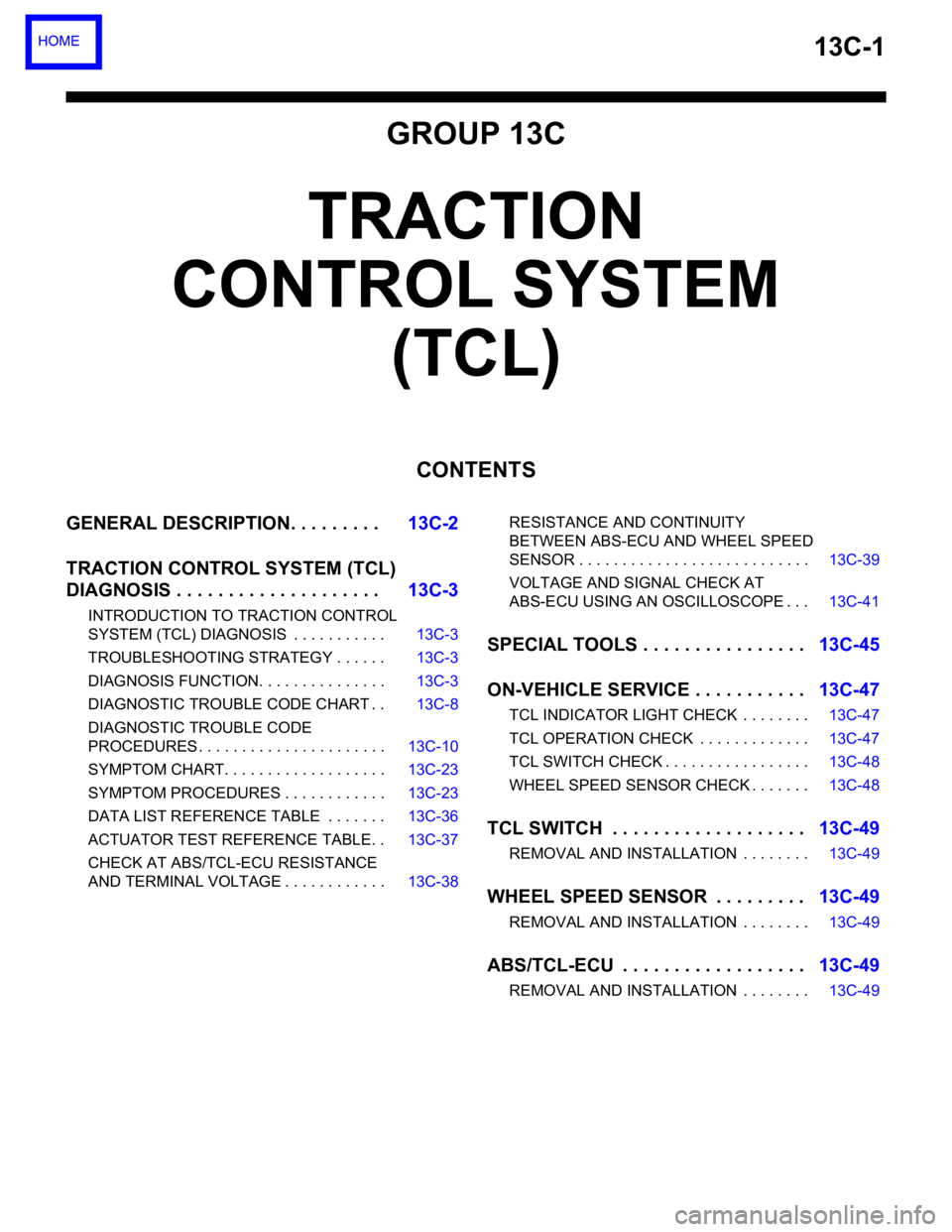
13C-1
GROUP 13C
TRACTION
CONTROL SYSTEM
(TCL)
CONTENTS
GENERAL DESCRIPTION. . . . . . . . .13C-2
TRACTION CONTROL SYSTEM (TCL)
DIAGNOSIS . . . . . . . . . . . . . . . . . . . .13C-3
INTRODUCTION TO TRACTION CONTROL
SYSTEM (TCL) DIAGNOSIS . . . . . . . . . . . 13C-3
TROUBLESHOOTING STRATEGY . . . . . . 13C-3
DIAGNOSIS FUNCTION. . . . . . . . . . . . . . . 13C-3
DIAGNOSTIC TROUBLE CODE CHART . . 13C-8
DIAGNOSTIC TROUBLE CODE
PROCEDURES . . . . . . . . . . . . . . . . . . . . . . 13C-10
SYMPTOM CHART. . . . . . . . . . . . . . . . . . . 13C-23
SYMPTOM PROCEDURES . . . . . . . . . . . . 13C-23
DATA LIST REFERENCE TABLE . . . . . . . 13C-36
ACTUATOR TEST REFERENCE TABLE. . 13C-37
CHECK AT ABS/TCL-ECU RESISTANCE
AND TERMINAL VOLTAGE . . . . . . . . . . . . 13C-38RESISTANCE AND CONTINUITY
BETWEEN ABS-ECU AND WHEEL SPEED
SENSOR . . . . . . . . . . . . . . . . . . . . . . . . . . . 13C-39
VOLTAGE AND SIGNAL CHECK AT
ABS-ECU USING AN OSCILLOSCOPE . . . 13C-41
SPECIAL TOOLS . . . . . . . . . . . . . . . .13C-45
ON-VEHICLE SERVICE . . . . . . . . . . .13C-47
TCL INDICATOR LIGHT CHECK . . . . . . . . 13C-47
TCL OPERATION CHECK . . . . . . . . . . . . . 13C-47
TCL SWITCH CHECK . . . . . . . . . . . . . . . . . 13C-48
WHEEL SPEED SENSOR CHECK . . . . . . . 13C-48
TCL SWITCH . . . . . . . . . . . . . . . . . . .13C-49
REMOVAL AND INSTALLATION . . . . . . . . 13C-49
WHEEL SPEED SENSOR . . . . . . . . .13C-49
REMOVAL AND INSTALLATION . . . . . . . . 13C-49
ABS/TCL-ECU . . . . . . . . . . . . . . . . . .13C-49
REMOVAL AND INSTALLATION . . . . . . . . 13C-49
Page 1307 of 1500
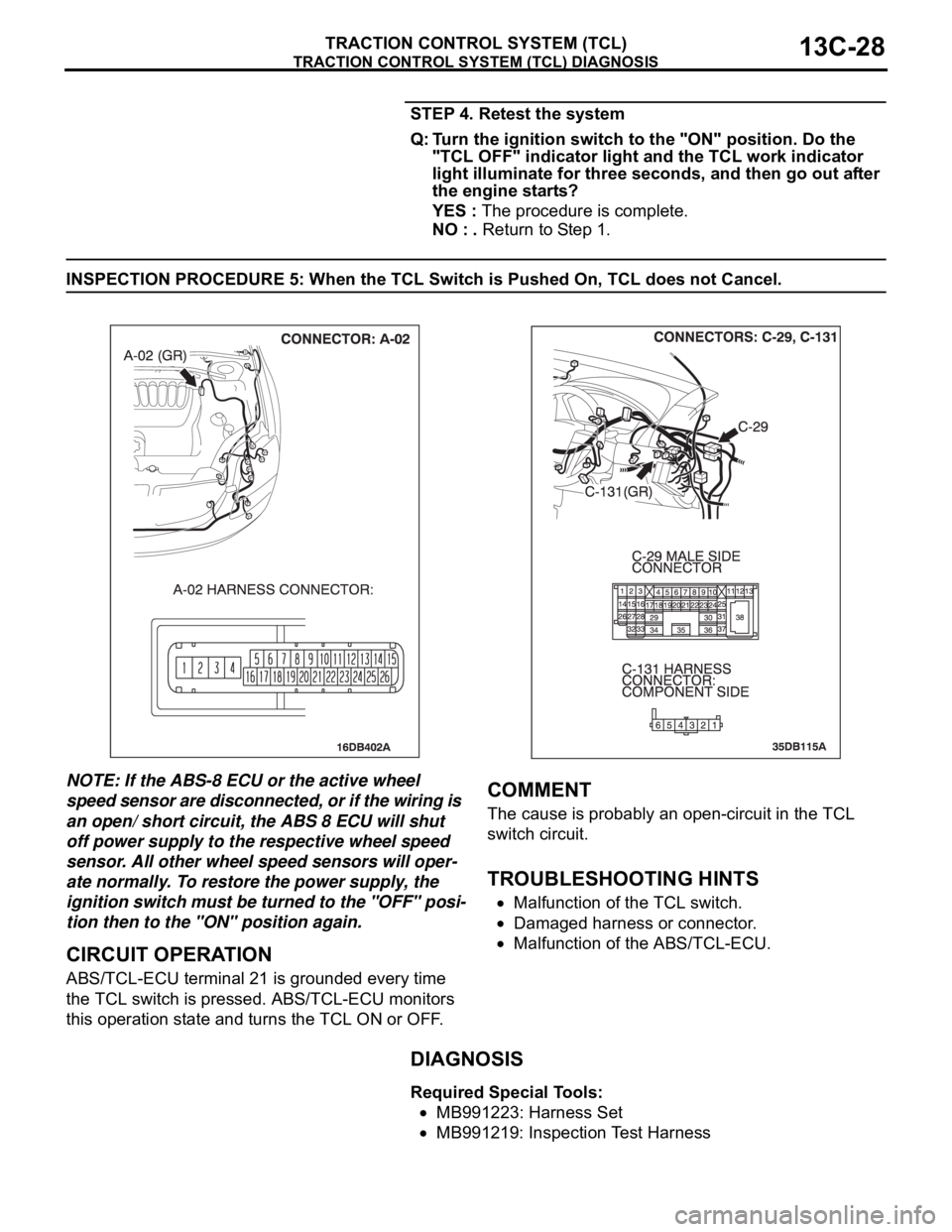
TRACTION CONTROL SYSTEM (TCL) DIAGNOSIS
TRACTION CONTROL SYSTEM (TCL)13C-28
STEP 4. Retest the system
Q: Turn the ignition switch to the "ON" position. Do the
"TCL OFF" indicator light and the TCL work indicator
light illuminate for three seconds, and then go out after
the engine starts?
YES : The procedure is complete.
NO : . Return to Step 1.
INSPECTION PROCEDURE 5: When the TCL Switch is Pushed On, TCL does not Cancel.
NOTE: If the ABS-8 ECU or the active wheel
speed sensor are disconnected, or if the wiring is
an open/ short circuit, the ABS 8 ECU will shut
off power supply to the respective wheel speed
sensor. All other wheel speed sensors will oper-
ate normally. To restore the power supply, the
ignition switch must be turned to the "OFF" posi-
tion then to the "ON" position again.
.
CIRCUIT OPERATION
ABS/TCL-ECU terminal 21 is grounded every time
the TCL switch is pressed. ABS/TCL-ECU monitors
this operation state and turns the TCL ON or OFF.
.
COMMENT
The cause is probably an open-circuit in the TCL
switch circuit.
.
TROUBLESHOOTING HINTS
Malfunction of the TCL switch.
Damaged harness or connector.
Malfunction of the ABS/TCL-ECU.
DIAGNOSIS
Required Special Tools:
MB991223: Harness Set
MB991219: Inspection Test Harness
Page 1384 of 1500
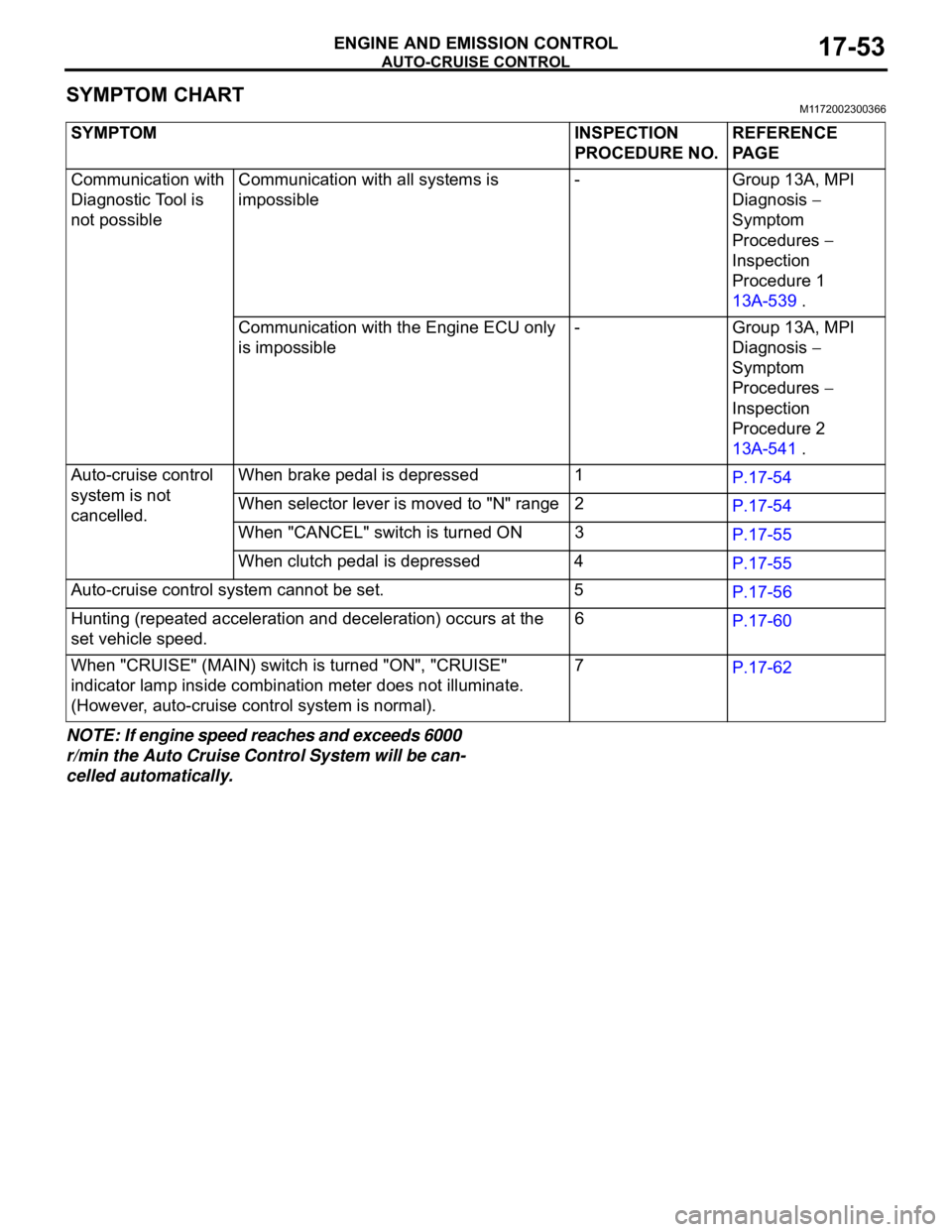
AUTO-CRUISE CONTROL
ENGINE AND EMISSION CONTROL17-53
SYMPTOM CHARTM1172002300366
NOTE: If engine speed reaches and exceeds 6000
r/min the Auto Cruise Control System will be can-
celled automatically.SYMPTOM INSPECTION
PROCEDURE NO.REFERENCE
PA G E
Communication with
Diagnostic Tool is
not possibleCommunication with all systems is
impossible- Group 13A, MPI
Diagnosis
Symptom
Procedures
Inspection
Procedure 1
13A-539 .
Communication with the Engine ECU only
is impossible- Group 13A, MPI
Diagnosis
Symptom
Procedures
Inspection
Procedure 2
13A-541 .
Auto-cruise control
system is not
cancelled.When brake pedal is depressed 1
P.17-54
When selector lever is moved to "N" range 2
P.17-54
When "CANCEL" switch is turned ON 3
P.17-55
When clutch pedal is depressed 4
P.17-55
Auto-cruise control system cannot be set. 5
P.17-56
Hunting (repeated acceleration and deceleration) occurs at the
set vehicle speed.6
P.17-60
When "CRUISE" (MAIN) switch is turned "ON", "CRUISE"
indicator lamp inside combination meter does not illuminate.
(However, auto-cruise control system is normal).7
P.17-62
Page 1402 of 1500
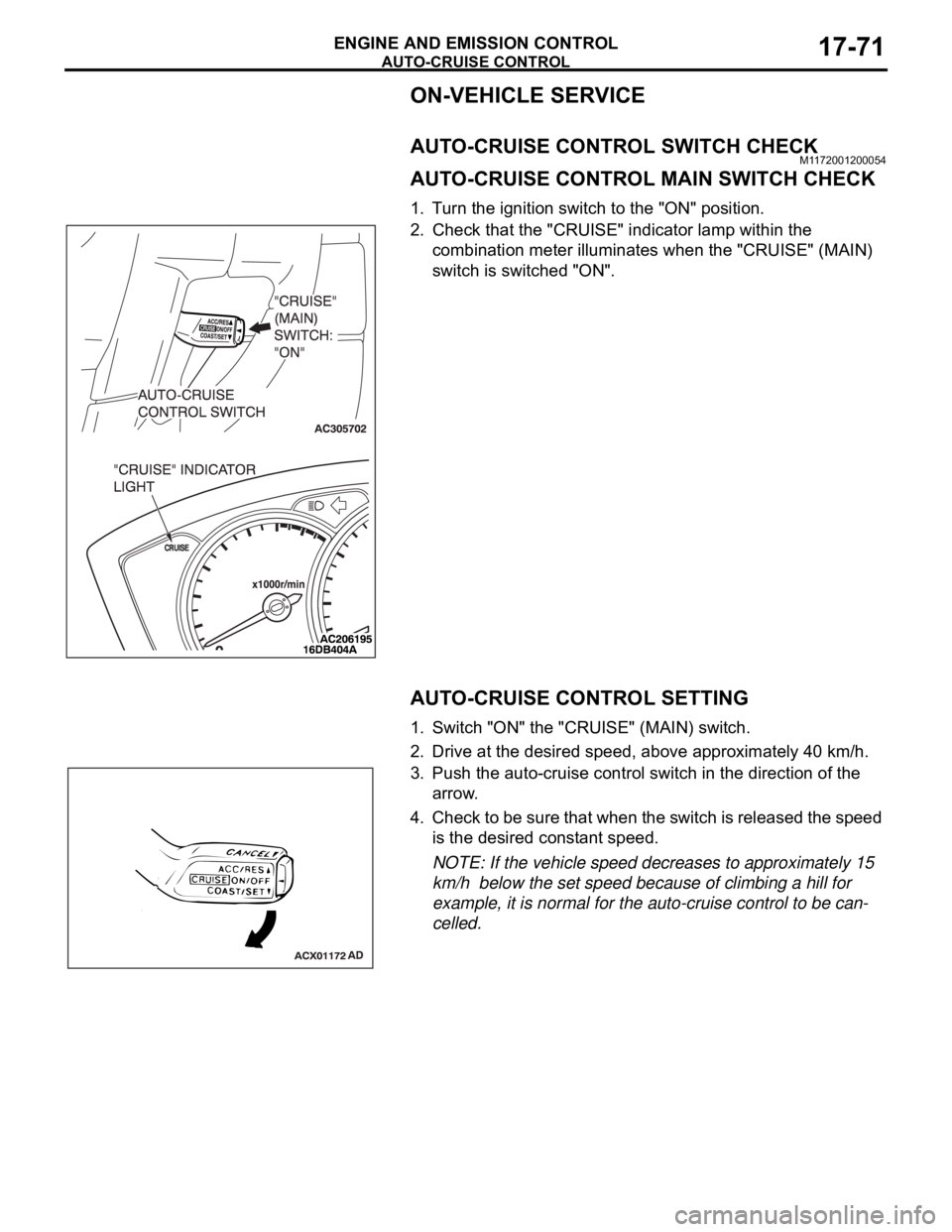
AUTO-CRUISE CONTROL
ENGINE AND EMISSION CONTROL17-71
ON-VEHICLE SERVICE
AUTO-CRUISE CONTROL SWITCH CHECKM1172001200054
AUTO-CRUISE CONTROL MAIN SWITCH CHECK
1. Turn the ignition switch to the "ON" position.
2. Check that the "CRUISE" indicator lamp within the
combination meter illuminates when the "CRUISE" (MAIN)
switch is switched "ON".
AUTO-CRUISE CONTROL SETTING
1. Switch "ON" the "CRUISE" (MAIN) switch.
2. Drive at the desired speed, above approximately 40 km/h.
3. Push the auto-cruise control switch in the direction of the
arrow.
4. Check to be sure that when the switch is released the speed
is the desired constant speed.
NOTE: If the vehicle speed decreases to approximately 15
km/h below the set speed because of climbing a hill for
example, it is normal for the auto-cruise control to be can-
celled.
Page 1472 of 1500
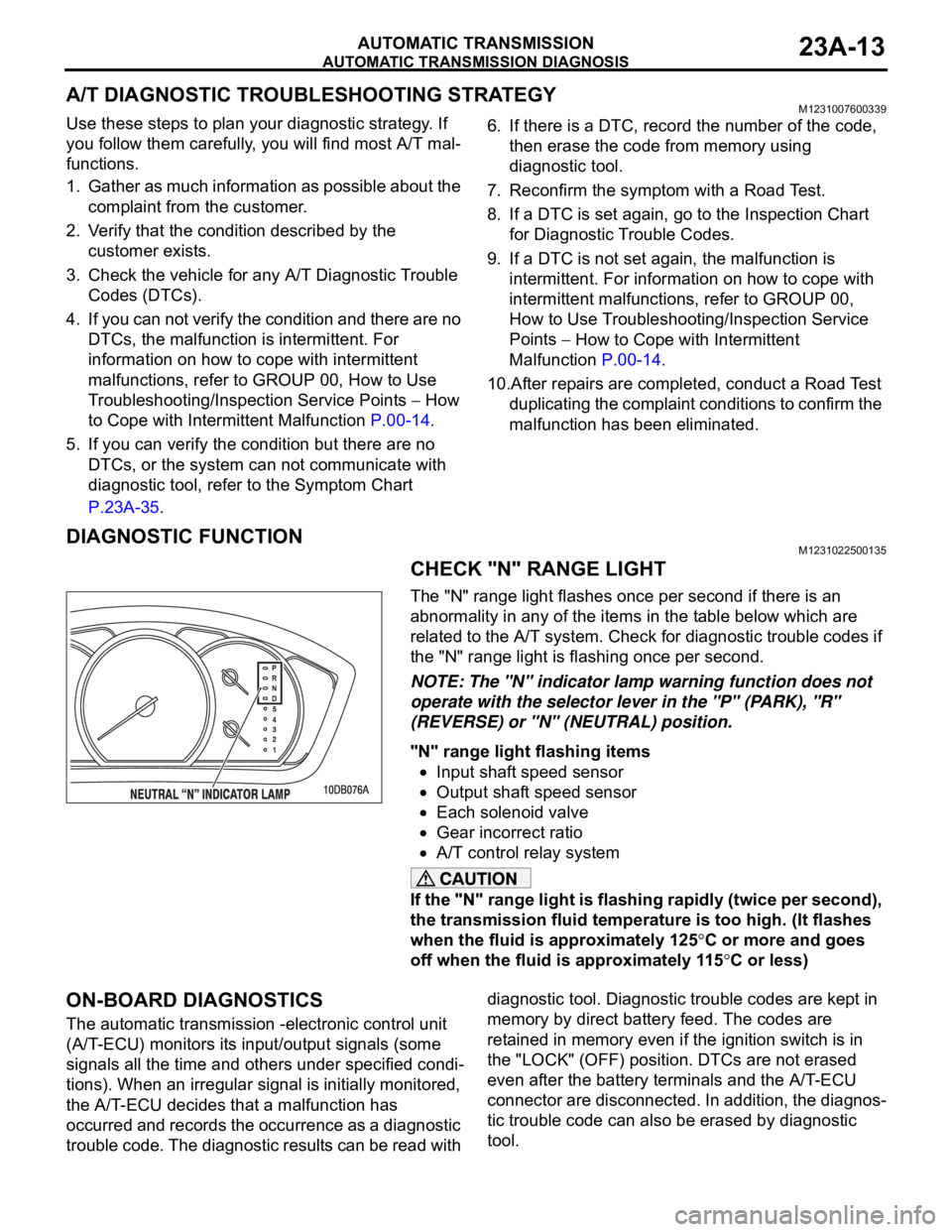
AUTOMATIC TRANSMISSION DIAGNOSIS
AUTOMATIC TRANSMISSION23A-13
A/T DIAGNOSTIC TROUBLESHOOTING STRATEGYM1231007600339
Use these steps to plan your diagnostic strategy. If
you follow them carefully, you will find most A/T mal-
functions.
1. Gather as much information as possible about the
complaint from the customer.
2. Verify that the condition described by the
customer exists.
3. Check the vehicle for any A/T Diagnostic Trouble
Codes (DTCs).
4. If you can not verify the condition and there are no
DTCs, the malfunction is intermittent. For
information on how to cope with intermittent
malfunctions, refer to GROUP 00, How to Use
Troubleshooting/Inspection Service Points
How
to Cope with Intermittent Malfunction P.00-14.
5. If you can verify the condition but there are no
DTCs, or the system can not communicate with
diagnostic tool, refer to the Symptom Chart
P.23A-35.6. If there is a DTC, record the number of the code,
then erase the code from memory using
diagnostic tool.
7. Reconfirm the symptom with a Road Test.
8. If a DTC is set again, go to the Inspection Chart
for Diagnostic Trouble Codes.
9. If a DTC is not set again, the malfunction is
intermittent. For information on how to cope with
intermittent malfunctions, refer to GROUP 00,
How to Use Troubleshooting/Inspection Service
Points
How to Cope with Intermittent
Malfunction P.00-14.
10.After repairs are completed, conduct a Road Test
duplicating the complaint conditions to confirm the
malfunction has been eliminated.
DIAGNOSTIC FUNCTIONM1231022500135
CHECK "N" RANGE LIGHT
The "N" range light flashes once per second if there is an
abnormality in any of the items in the table below which are
related to the A/T system. Check for diagnostic trouble codes if
the "N" range light is flashing once per second.
NOTE: The "N" indicator lamp warning function does not
operate with the selector lever in the "P" (PARK), "R"
(REVERSE) or "N" (NEUTRAL) position.
"N" range light flashing items
Input shaft speed sensor
Output shaft speed sensor
Each solenoid valve
Gear incorrect ratio
A/T control relay system
If the "N" range light is flashing rapidly (twice per second),
the transmission fluid temperature is too high. (It flashes
when the fluid is approximately 125
C or more and goes
off when the fluid is approximately 115
C or less)
ON-BOARD DIAGNOSTICS
The automatic transmission -electronic control unit
(A/T-ECU) monitors its input/output signals (some
signals all the time and others under specified condi-
tions). When an irregular signal is initially monitored,
the A/T-ECU decides that a malfunction has
occurred and records the occurrence as a diagnostic
trouble code. The diagnostic results can be read with diagnostic tool. Diagnostic trouble codes are kept in
memory by direct battery feed. The codes are
retained in memory even if the ignition switch is in
the "LOCK" (OFF) position. DTCs are not erased
even after the battery terminals and the A/T-ECU
connector are disconnected. In addition, the diagnos-
tic trouble code can also be erased by diagnostic
tool.